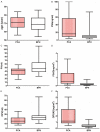Ratio of prostate specific antigen to the outer gland volume of prostrate as a predictor for prostate cancer
- PMID: 25337254
- PMCID: PMC4203225
Ratio of prostate specific antigen to the outer gland volume of prostrate as a predictor for prostate cancer
Abstract
Objective: As a definite diagnosis of prostate cancer, puncture biopsy of the prostate is invasive method. The aim of this study was to evaluate the value of OPSAD (the ratio of PSA to the outer gland volume of prostate) as a non-invasive screening and diagnosis method for prostate cancer in a select population.
Methods: The diagnosis data of 490 subjects undergoing ultrasound-guided biopsy of the prostate were retrospectively analyzed. This included 133 patients with prostate cancer, and 357 patients with benign prostate hyperplasia (BPH).
Results: The OPSAD was significantly greater in patients with prostate cancer (1.87 ± 1.26 ng/ml(2)) than those with BPH (0.44 ± 0.21 ng/ml(2)) (P < 0.05). Receiver operating characteristic (ROC) curve analysis revealed that the performance of OPSAD as a diagnostic tool is superior to PSA and PSAD for the diagnosis of prostate cancer. In the different groups divided according to the Gleason score of prostate cancer, OPSAD is elevated with the rise of the Gleason score.
Conclusion: OPSAD may be used as a new indicator for the diagnosis and prognosis of prostate cancer, and it can reduce the use of unnecessary puncture biopsy of the prostate.
Keywords: Prostate cancer; benign prostate hyperplasia; diagnosis; outer gland of the prostate; prostate specific antigen; prostate specific antigen density.
Figures



Similar articles
-
Diagnosis of Prostate Cancer in Patients with Prostate-Specific Antigen (PSA) in the Gray Area: Construction of 2 Predictive Models.Med Sci Monit. 2021 Feb 8;27:e929913. doi: 10.12659/MSM.929913. Med Sci Monit. 2021. PMID: 33556045 Free PMC article.
-
[Usefulness and predictive value of PSA density, adjusted by transition zone volume, in men with PSA levels between 2 and 4 ng/ml].Actas Urol Esp. 2012 Feb;36(2):93-8. doi: 10.1016/j.acuro.2011.06.025. Epub 2011 Dec 19. Actas Urol Esp. 2012. PMID: 22188752 Spanish.
-
Additional value of the ratio of serum total testosterone to total prostate-specific antigen in the diagnosis of prostate cancer in a Chinese population.Andrologia. 2018 Mar;50(2). doi: 10.1111/and.12872. Epub 2017 Jul 27. Andrologia. 2018. PMID: 28752596
-
Detection of prostate carcinoma using prostate specific antigen, its density, and the density of the transition zone in Japanese men with intermediate serum prostate specific antigen concentrations.Cancer. 1997 May 15;79(10):1969-76. doi: 10.1002/(sici)1097-0142(19970515)79:10<1969::aid-cncr19>3.0.co;2-t. Cancer. 1997. PMID: 9149025
-
Benign prostatic hyperplasia and prostate-specific antigen.Vojnosanit Pregl. 2015 May;72(5):447-53. Vojnosanit Pregl. 2015. PMID: 26165054 Review. No abstract available.
Cited by
-
Informative gene selection and the direct classification of tumors based on relative simplicity.BMC Bioinformatics. 2016 Jan 20;17:44. doi: 10.1186/s12859-016-0893-0. BMC Bioinformatics. 2016. PMID: 26792270 Free PMC article.
-
Silencing of CCR7 inhibits the growth, invasion and migration of prostate cancer cells induced by VEGFC.Int J Clin Exp Pathol. 2015 Oct 1;8(10):12533-40. eCollection 2015. Int J Clin Exp Pathol. 2015. PMID: 26722441 Free PMC article.
References
-
- Siegel R, Ma J, Zou Z, Jemal A. Cancer statistics, 2014. CA Cancer J Clin. 2014;64:9–29. - PubMed
-
- Huang M, Lin Y, Xu A, Uhlman M, Deng X, Lin X, Wu S, Diao P, Xie K, Tang P. Percent free prostate-specific antigen does not improve the effectiveness of prostate cancer detection in Chinese men with a prostate-specific antigen of 2.5-20.0 ng/ml: a multicenter study. Med Oncol. 2014;31:925. - PubMed
-
- Lee F, Siders DB, Torp-Pedersen ST, Kirscht JL, McHugh TA, Mitchell AE. Prostate cancer: transrectal ultrasound and pathology comparison. A preliminary study of outer gland (peripheral and central zones) and inner gland (transition zone) cancer. Cancer. 1991;67:1132–1142. - PubMed
MeSH terms
Substances
LinkOut - more resources
Full Text Sources
Medical
Research Materials
Miscellaneous
